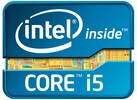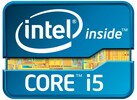Intel Core i5-2415M vs Intel Core i5-2435M
Intel Core i5-2415M
► remove from comparison
The Intel Core i5-2415M is a fast dual core processor at the time of introduction in Q1 2011. It is based on the Sandy Bridge architecture and offers Hyperthreading to handle 4 threads at once (for a better usage of the pipeline). Compared to the similar Core i5-2410M, the 2415M is manufactured with a smaller package and only for the BGA1023 socket. In difference to the faster Core i7, the i5 offers a smaller last level cache of 3MB. The base clock speed is 2.3 GHz but due to Turbo Boost it can reach 2.6 GHz (2 cores active) and 2.9 GHz (1 core active). Compared to the 2510M, the 2415M does not support AES, VT-d, and Trusted Execution functions.
Sandy Bridge is the evolutionary successor of the Arrandale architecture. The most noteable improvements is the improved Turbo 2.0 and the integration of the graphics card into the 32nm CPU core.
The i5-2415M offers an integrated graphics card ( Intel HD Graphics 3000) which is clearly faster then the older Intel HD Graphics in the Arrandale CPUs. As the new GPU is included in the CPU, it is also manufactured in 32nm and shares the fast level 3 cache with the CPU cores (using a new ring bus). In the 2415M it is clocked from 650-1200MHz (with Turbo Boost). The faster Sandy Bridge CPUs are clocked up to 1300 MHz (like the i5-2520M).
Furthermore, an improved dual-channel DDR3 memory controller is included on the CPU die that is used by the CPU and GPU part.
Due to the improved architecture and the new Turbo Boost 2.0, the average performance of the Core i5-2415M is higher than a similar clocked Arrandale Core i5. In our benchmarks, the 2415M was able to beat the fast Intel Core i5-560M with 2.7-3.2GHz and is therefore suited for even demanding tasks. Detailed benchmarks can be found below and on the detail page of the similar Core i5-2410M.
The 35W TDP rating includes the integrated GPU and memory controller.
Intel Core i5-2435M
► remove from comparison
The Intel Core i5-2435M is a fast dual core processor at the time of introduction in Q3 2011. It is based on the Sandy Bridge architecture and offers Hyperthreading to handle 4 threads at once (for a better usage of the pipeline). Compared to the faster Core i7, the i5 offers a smaller last level cache of 3MB. The base clock speed is 2.4 GHz but due to Turbo Boost it can reach 2.7 GHz (2 cores active) and 3 GHz (1 core active). Compared to the 2510M, the 2435M does not support AES, VT-d, and Trusted Execution functions.
Sandy Bridge is the evolutionary successor of the Arrandale architecture. The most noteable improvements is the improved Turbo 2.0 and the integration of the graphics card into the 32nm CPU core.
The i5-2435M offers an integrated graphics card (Intel HD Graphics 3000) which is clearly faster then the older Intel HD Graphics in the Arrandale CPUs. As the new GPU is included in the CPU, it is also manufactured in 32nm and shares the fast level 3 cache with the CPU cores (using a new ring bus). In the 2435M it is clocked from 650-1300MHz (with Turbo Boost). In comparison the quite similar i5-2430M offers only 1200MHz.
Furthermore, an improved dual-channel DDR3 memory controller is included on the CPU die that is used by the CPU and GPU part.
Due to the improved architecture and the new Turbo Boost 2.0, the average performance of the Core i5-2435M is higher than a similar clocked Arrandale Core i5. In our benchmarks, the 2435M was able to beat the fast Intel Core i5-560M with 2.7-3.2GHz and is therefore suited for even demanding tasks.
The 35W TDP rating includes the integrated GPU and memory controller.
| Model | Intel Core i5-2415M | Intel Core i5-2435M | ||||||||||||||||||||||||||||||||||||||||||||||||||||||||||||||||||||||||||||||||
| Codename | Sandy Bridge | Sandy Bridge | ||||||||||||||||||||||||||||||||||||||||||||||||||||||||||||||||||||||||||||||||
| Series | Intel Core i5 | Intel Core i5 | ||||||||||||||||||||||||||||||||||||||||||||||||||||||||||||||||||||||||||||||||
| Series: Core i5 Sandy Bridge |
|
| ||||||||||||||||||||||||||||||||||||||||||||||||||||||||||||||||||||||||||||||||
| Clock | 2300 - 2900 MHz | 2400 - 3000 MHz | ||||||||||||||||||||||||||||||||||||||||||||||||||||||||||||||||||||||||||||||||
| L1 Cache | 128 KB | 128 KB | ||||||||||||||||||||||||||||||||||||||||||||||||||||||||||||||||||||||||||||||||
| L2 Cache | 512 KB | 512 KB | ||||||||||||||||||||||||||||||||||||||||||||||||||||||||||||||||||||||||||||||||
| L3 Cache | 3 MB | 3 MB | ||||||||||||||||||||||||||||||||||||||||||||||||||||||||||||||||||||||||||||||||
| Cores / Threads | 2 / 4 | 2 / 4 | ||||||||||||||||||||||||||||||||||||||||||||||||||||||||||||||||||||||||||||||||
| TDP | 35 Watt | 35 Watt | ||||||||||||||||||||||||||||||||||||||||||||||||||||||||||||||||||||||||||||||||
| Transistors | 624 Million | 624 Million | ||||||||||||||||||||||||||||||||||||||||||||||||||||||||||||||||||||||||||||||||
| Technology | 32 nm | 32 nm | ||||||||||||||||||||||||||||||||||||||||||||||||||||||||||||||||||||||||||||||||
| Die Size | 149 mm2 | 149 mm2 | ||||||||||||||||||||||||||||||||||||||||||||||||||||||||||||||||||||||||||||||||
| max. Temp. | 100 °C | |||||||||||||||||||||||||||||||||||||||||||||||||||||||||||||||||||||||||||||||||
| Socket | BGA1023 | FCBGA1023 | ||||||||||||||||||||||||||||||||||||||||||||||||||||||||||||||||||||||||||||||||
| Features | HD Graphics 3000 (650-1200MHz), DDR3-1066/1333 Memory Controller (max 8GB), HyperThreading, AVX, Quick Sync, Virtualization | HD Graphics 3000, DDR3-1066/1333 Memory Controller (max 8GB), HyperThreading, AVX, Quick Sync, Virtualization | ||||||||||||||||||||||||||||||||||||||||||||||||||||||||||||||||||||||||||||||||
| iGPU | Intel HD Graphics 3000 (650 - 1300 MHz) | Intel HD Graphics 3000 (650 - 1300 MHz) | ||||||||||||||||||||||||||||||||||||||||||||||||||||||||||||||||||||||||||||||||
| Architecture | x86 | x86 | ||||||||||||||||||||||||||||||||||||||||||||||||||||||||||||||||||||||||||||||||
| Announced |
Benchmarks
Average Benchmarks Intel Core i5-2415M → 0% n=0
* Smaller numbers mean a higher performance
1 This benchmark is not used for the average calculation












